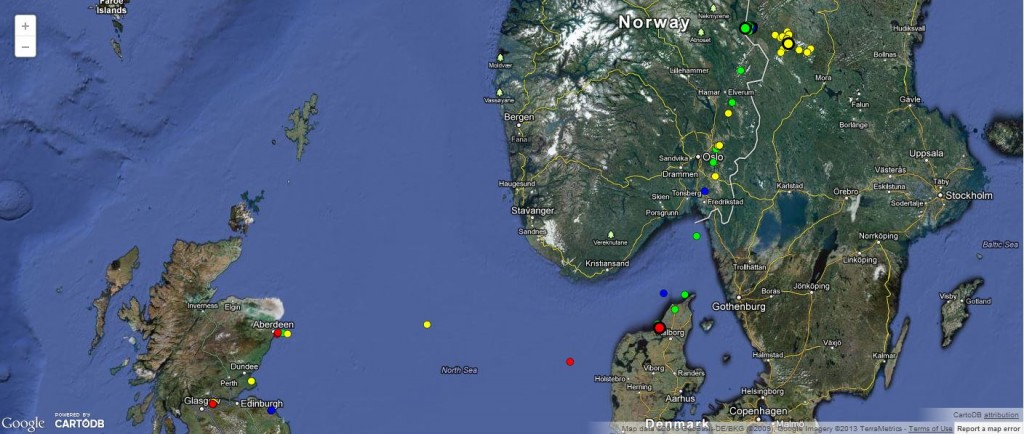Bean goose breeding grounds revealed by GPS
 GPS tracking has revealed for the first time the migration of Scotland’s only bean goose flock.
GPS tracking has revealed for the first time the migration of Scotland’s only bean goose flock.
Scientists from WWT, commissioned by Scottish Natural Heritage (SNH), fitted tracking devices to six taiga bean geese on the Slamannan plateau last winter.
Detailed data from the 19 gram GPS tags tracked the birds’ movement daily within Scotland and then across the North Sea, through Denmark and Norway and finally to Sweden.
Once common in Scotland, bean geese have become extremely rare over the past century and now just one flock of about 250 birds winters on the Slamannan plateau near Falkirk. Only one other, even smaller, flock winters in the UK in Norfolk.
Carl Mitchell of the Wildfowl & Wetlands Trust said:
"Understanding the daily movements and migration route of Scotland’s only regular flock of bean geese in relation to proposed wind turbine developments is essential to safeguard this important population. Discovering stopover locations on their spring migration and their breeding grounds has filled a huge gap in our understanding of the life cycle of these geese."
When the geese left Scotland in late February, they spent a further month feeding on stubble fields in Jylland, northwest Denmark before the next leg of their migration.
In late March, the flock travelled to fields 40km north east of Oslo, Norway, where they fed for two weeks before moving 200km further north to the forested Dalarna County of west Sweden. Here they have settled in what is thought to be their breeding grounds.
Pupils from Slamannan and Greengairs primary schools have followed the birds’ story from tagging through to arriving in Dalarna County. The children have been involved in the bean goose project for several years, learning about netting geese for tagging, GPS tracking, and international bird populations, and making artwork, puppets and a short film about the geese. It is hoped that six or so of the pupils will be able to travel to Sweden in 2014.

Caroline Crawford, SNH project officer, said:
“It was quite exciting to track the geese and finally learn their route home to breed after all these years. This information will be crucial to help us understand and protect these special birds. It was also terrific to have all the children involved, learning about these special geese and seeing their enthusiasm and wonderful art.”
Angus Maciver, of the Bean Goose Action Group said:
"It has been a very interesting winter following the distribution of the tagged bean geese on the Slamannan Plateau and relating that to our previous knowledge. Their spring migration has been exciting to watch with new information on the birds’ whereabouts being discovered every other day."
Allison Leonard of RSPB Scotland said:
“It’s great that this technology allows us to inform conservation and education in this way. With each download from the collars, we have learned just a little bit more about the geese, helping us to protect them in their wintering and breeding grounds."
See the birds’ migration route online.
Notes:
- The Slamannan plateau lies between Falkirk and Cumbernauld. Bean geese were first seen in the area during the 1980s, and their numbers and distribution have been monitored annually since the early 1990s. Since then the population has grown to approximately 250 birds. The bean geese arrive in the area in late September each year and leave in late February.
- The study is a collaborative project undertaken for the Bean Goose Action Group (BGSG) by Scottish Natural Heritage (SNH), The Wildfowl & Wetlands Trust (WWT), the Royal Society for the Protection of Birds Scotland (RSPB Scotland) and with kind permission of the Hunter family of Luckenburn Farm.
- Taiga bean geese are one of only four goose populations showing significant declines in Europe. Numbers have fallen from approximately 100,000 geese in 1995 to about 60,000-65,000 in 2008/09.
- In recognition of the importance of the bean geese at Slamannan, a Bean Goose Action Group was established in 1994. The group aims to help conserve the population by protecting and managing the habitats used by the geese, and overseeing the annual monitoring. The group includes representatives from Scottish Natural Heritage, Falkirk and North Lanarkshire Councils, Royal Society for the Protection of Birds and Central Scotland Forest Trust.
- The Slamannan plateau was made a European Special Protection Area for the bean geese in 2008. SPAs are designated under the EC Birds Directive. They cover an area of over 600,000ha for a wide range of species. SPAs are intended to safeguard the habitats of the species for which they are selected and to protect the birds from significant disturbance. SPAs, together with Special Areas of Conservation (which are designated under the Habitats Directive for habitats and non-bird species), form the Natura 2000 network of sites, which is a pan-EU network of sites for nature conservation for the 21st century and beyond. This protection under EC law, follows from designation under domestic law as a Site of Special Scientific Interest by Scottish Natural Heritage in September 2007.

